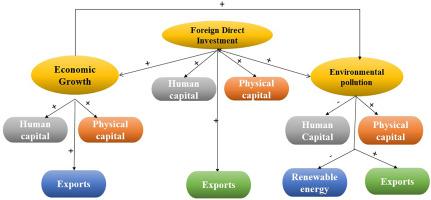Environmental Impact Assessment Review ( IF 6.122 ) Pub Date : 2021-08-17 , DOI: 10.1016/j.eiar.2021.106664 Yexing Yin 1 , Xinruo Xiong 2 , Jamal Hussain 1, 3

|
This paper examines the causal links between foreign direct investment (FDI), CO2 emissions, and economic growth in a global panel of 101 countries and four diverse income groups (low, lower-middle, upper-middle, and high) countries using the simultaneous equations framework, with data from 1990 to 2014. Considering physical capital and human capital, this is the first time these two determinants have been linked to the FDI-pollution-growth simultaneous equation model. The dependent variables in the three simultaneous equations are inflow of foreign direct investment, CO2 emissions as a proxy for environmental pollution, and real gross domestic product. Three critical inferences can be drawn from the results. First, there is a two-way causal relationship between growth and FDI in the global panel and across all income groups (except for lower-middle-income groups). Likewise, except for high-income countries, there is a two-way causal relationship between FDI and CO2 emissions in the global panel. Second, the results support a one-way causal relationship between economic growth and CO2 emissions in the global panel and the income subgroup, but only in the low-middle and high-income groups support the environmental Kuznets curve (EKC) and pollution haven hypothesis (PHH). Third, the heterogeneous impact of human and physical capital on the environment is genuinely striking: human capital improves its quality while physical capital degrades it. The results suggest that physical and human capital contributes to economic growth and attracts foreign direct investment.
中文翻译:

实物和人力资本在不同收入群体国家 FDI-污染-增长关系中的作用:同时性建模分析
本文在一个由 101 个国家和四个不同收入群体(低、中低、中高和高)国家组成的全球小组中,研究了外国直接投资 (FDI)、CO 2排放和经济增长之间的因果关系。联立方程框架,数据从 1990 年到 2014 年。考虑到物质资本和人力资本,这是第一次将这两个决定因素与 FDI-污染-增长联立方程模型联系起来。三个联立方程中的因变量为外商直接投资流入量、CO 2排放量作为环境污染和实际国内生产总值的代表。从结果中可以得出三个重要的推论。首先,全球面板和所有收入群体(中低收入群体除外)的增长与 FDI 之间存在双向因果关系。同样,除高收入国家外,全球面板中FDI 与 CO 2排放之间存在双向因果关系。其次,结果支持经济增长与 CO 2之间的单向因果关系全球面板和收入子组中的排放量,但仅在中低收入和高收入组中支持环境库兹涅茨曲线 (EKC) 和污染港假设 (PHH)。第三,人力资本和物质资本对环境的异质影响确实是惊人的:人力资本提高了其质量,而物质资本降低了它的质量。结果表明,物质和人力资本有助于经济增长并吸引外国直接投资。



























 京公网安备 11010802027423号
京公网安备 11010802027423号